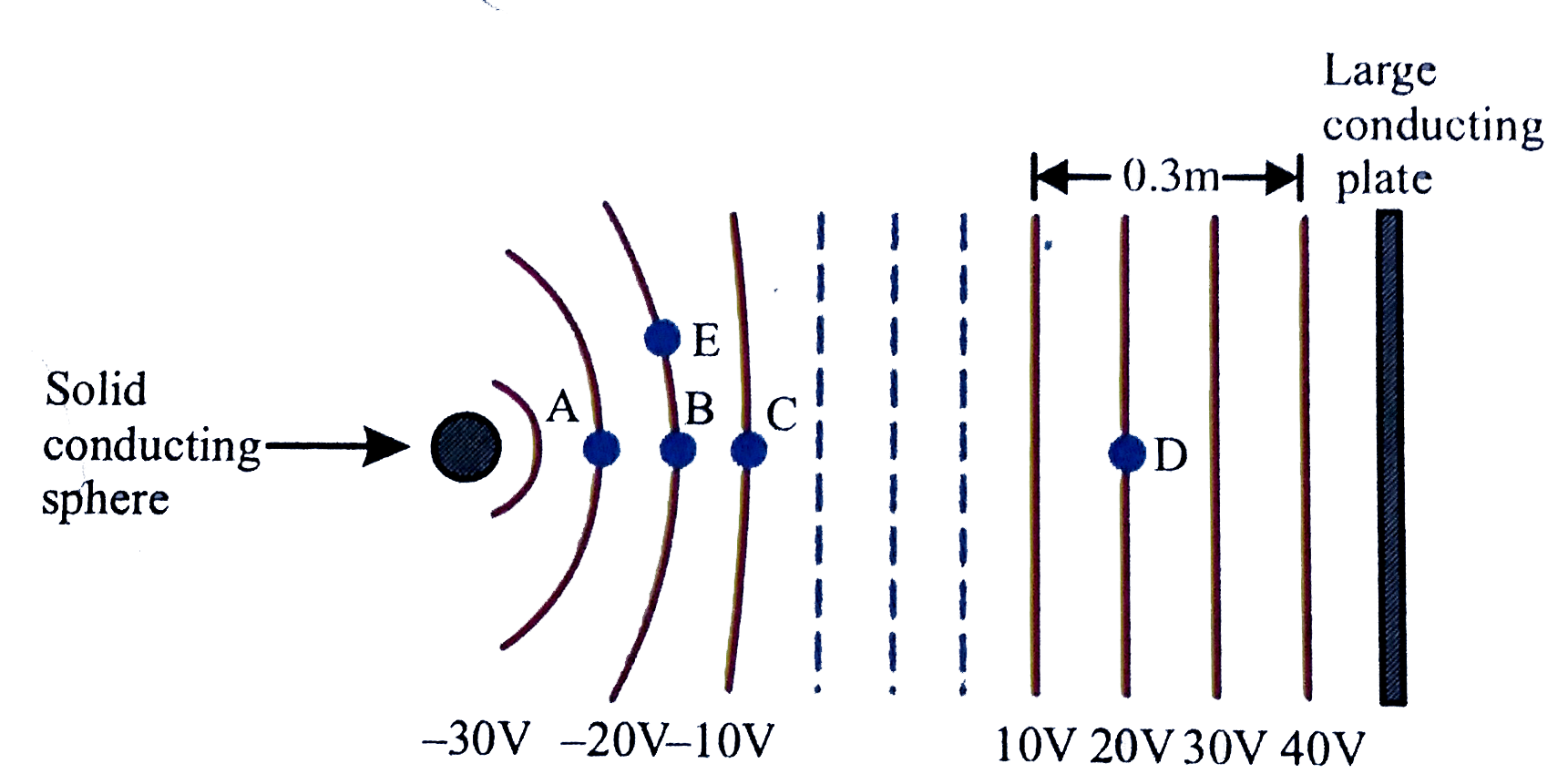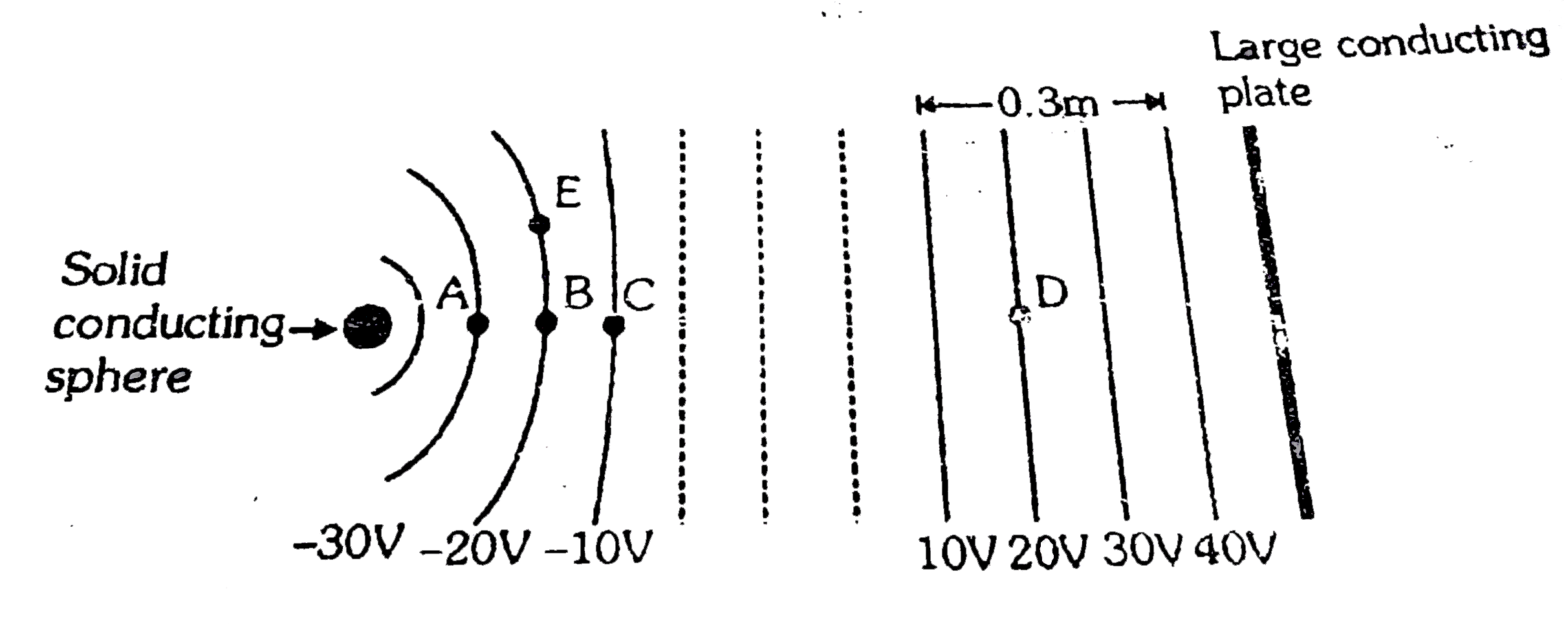The sketech below show cross secion so equipotential surfaces between two charged.Conductors that are shwon in solid black.Some points on the wquipotenital surfaces .near the conductors are marked as A,B,C….. The arrangements lies in air (Take ε0=8.85×10−12C2/Nm2]
![The sketech below show cross secion so equipotential surfaces between two charged.Conductors that are shwon in solid black.Some points on the wquipotenital surfaces .near the conductors are marked as A,B,C…. . The arrangements lies in air (Take epsilon(0)=8.85xx10^(-12)C^(2)//Nm^(2)] Surfaces charge density of the plate is equal to](https://d10lpgp6xz60nq.cloudfront.net/physics_images/NAR_PHY_XII_V02_C02_E01_387_Q01.png)
Surfaces charge density of the plate is equal to
8.85×10−10C/m2
−8.85×10−10C/m2
17.7×10−10C/m−2
−17.7×10−10C/m(2)
The correct Answer is:A
E=40−100.3=100V/m
(near the plate the electric field has to be uniform \it is alomost due to the particle
For conducting plate
E=σε0σ=ε0E
therefore s=8.85×10−12×100
=8.85×10−10C/m2
Topper's Solved these Questions
- ELECTROSTATICS AND GAUSS LAWBook:NARAYNAChapter:ELECTROSTATICS AND GAUSS LAWExercise:Passage II
Explore 3 Videos
- ELECTROSTATICS AND GAUSS LAWBook:NARAYNAChapter:ELECTROSTATICS AND GAUSS LAWExercise:Passage III
Explore 3 Videos
- ELECTROSTATICS AND GAUSS LAWBook:NARAYNAChapter:ELECTROSTATICS AND GAUSS LAWExercise:Level V
Explore 93 Videos
- ELECTROSTATIC POTENTIAL AND CAPACITANCEBook:NARAYNAChapter:ELECTROSTATIC POTENTIAL AND CAPACITANCEExercise:ADDITIONAL PROBLEMS
Explore 14 Videos
- EXPERIMENTAL PHYSICSBook:NARAYNAChapter:EXPERIMENTAL PHYSICSExercise:Comprehension type
Explore 6 Videos
Similar Questions
A point charge of 4.427 μC is at the centre of a cube Gaussian surface 9.0 cm on the edge. Find the net electric flux through the surface. (ε0=8.854×10−12C2N−1m−2)
View SolutionThe surface density of charge on the surface of a charged conductor in the air is 26.5μCm−2 . The the outward force per unit area of the charged conductor is (ε0=8.85×10−12C2N−1m−2)
View Solution
Knowledge Check
The sketech below show cross secion so equipotential surfaces between two charged.Conductors that are shwon in solid black.Some points on the wquipotenital surfaces .near the conductors are marked as A,B,C….. The arrangements lies in air (Take ε0=8.85×10−12C2/Nm2]

A positive charge is placed at B,When it is released:Ano force will be exerted on it .Bit will move towards ACit will move towards CDit will move towards EThe sketch below shows cross-sections of equipotential surface between two charged conductors that are shown in solid black. Some points one the euquipotential surface near the conductors are marked as A, B, C ………. The arrangement lies in air. [Take ∈0=8.85×10−12C2/Nm2]

How much work is required to slowly move a −1μC charge from E to D?A2×10−5JB−2×10−5JC4×10−5JD−4×10−5JThe surface density of charge on the surface of a charged conductor in air is 0.885μC/m2. If ε0=8.85×10−12C2/N−m2, then the outward force per unit area of the charged conductor is
A5×10−2N/m2B4.425×10−2N/m2C8.85×10−2N/m2D5×10−3N/m2
The displacement current density across a parallel plate air capacitor which is being charged at the rate of 1012V/m/s is (ε0=8.85×10−12C2N−1m−2):
View SolutionA metal plate of area 2m2 is charged with 12×10−6C. The surface surface density of charge is
View SolutionA metal plate of surface area 2m2 is charged with √8.85μC. What is the mechanical force acting on the plate if it is kept in air ? [ε0=8.85×10−12C2]
View SolutionEach plate of a parallel plate condenser has surface area of 5cm2. The distance between the plates is 2 mm. The dielectric constant of the medium between the plates is 5. Then the capacity of the condenser is
(ε0=8.85×10−12C2/Nm2)
View SolutionThe surface density of charge on a conductor situated in air, is 2×10−4C/m2. The electric intensity at a point very near to its surface is
View Solution

